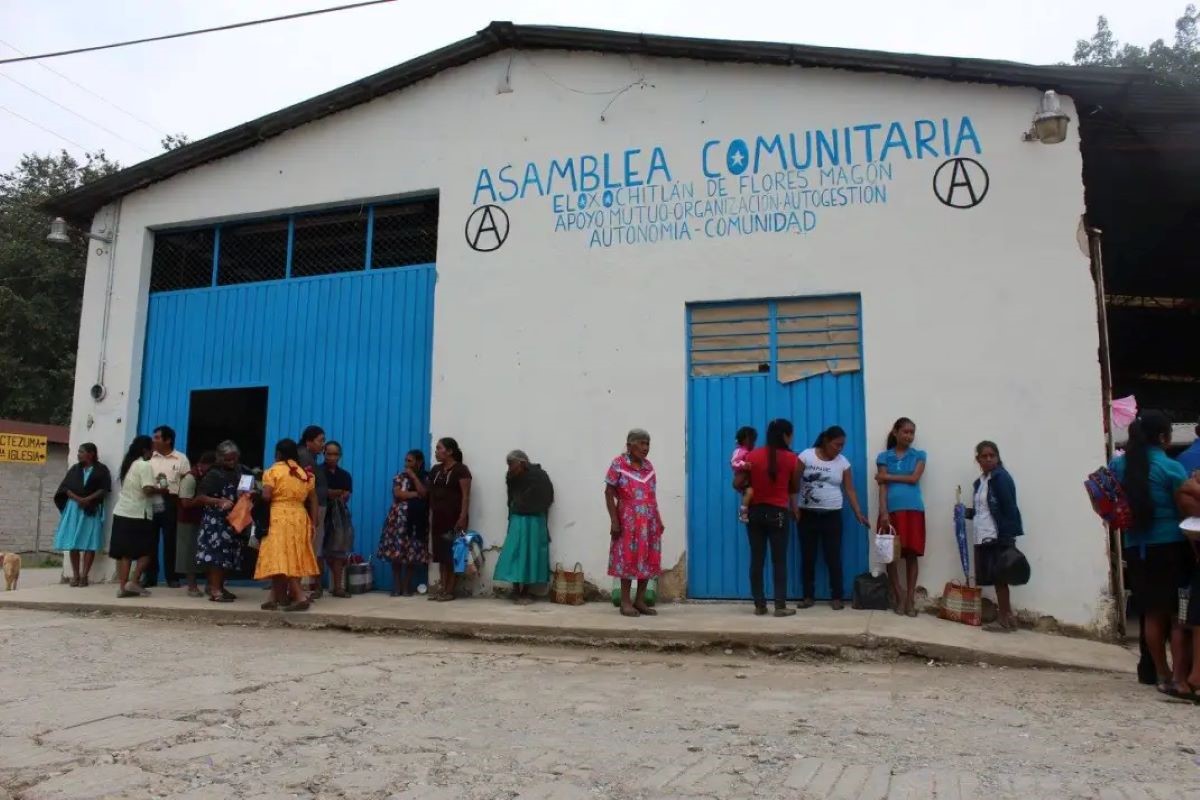Filed under: Community Organizing, Editorials, Featured, Indigenous, Land, Southern Mexico, The State

There is an unresolvable tension present in the valleys, mountains, deserts, jungles, and highlands of the southern Mexican state of Oaxaca, between the communal forms of social organization, and the forms and subjects of the State and capital. This tension dates back to the so-called conquest, and has remained permanent, although with different intensities, over the past 500 years.
It’s been often said that Oaxaca is communal, and it’s worth repeating. Different structures and expressions of community life—communal land, community assemblies, collective work, and communal festivities—are present in different forms, and at different scales, in the communities, agencies, and municipalities that make up the state of Oaxaca.
Of the 570 municipalities in the state, 418 of them organize and elect their authorities with the assembly as the maximum decision-making power in the municipality. Within municipalities, at more local levels, there are community and neighborhood level assemblies. There are also a multiplicity of other community and neighborhood collective structures, like councils of elders and women, neighborhood water, festival, and electricity committees, religious committees, and others, which depending on the specifics of the particular location, are organized around assemblies.
These different expressions of collective decision-making and collective management of basic necessities are complemented and strengthened by, and directly connected with other forms of collectivity: collective work in benefit of the community (tequios or faenas as they are called in Oaxaca), community festivities, extended family mutual aid and support, etc.
Perhaps most importantly is the ongoing existence of common lands. In Oaxaca around 80% of the land is collectively managed. Directly linked to the collectively managed lands are collective decision-making structures; communal lands are organized and managed by assemblies of comuneros, and ejidal lands are organized and managed by assemblies of ejido members.
It’s important to stress that these different forms of organization aren’t without their difficulties, and assemblies aren’t anywhere near perfect, nor are they the answer to everything. These different processes on the ground are riddled with complexities, local power struggles, pressure from governments to control, regulate, and co-opt. Yet, they represent the power of collective and communal organization in Oaxaca, and they have shown to be a powerful force in defense of autonomy and territory.
It goes without saying, these different communal and collective forms of organization often clash with the interests of the State to individualize, map, regulate, register, and control, and the interests of capital to dispossess, exploit, privatize, and plunder. The tactics of the State and capital to dis-articulate these communal forms of organization have taken a variety of different forms from assassinations and imprisonment of community organizers, to community division and co-optation. Collectively managed lands have continually been in the State and capital’s crosshairs.
In 1992, the Mexican president passed an agrarian reform setting the stage for the signing of North American Free Trade Agreement (NAFTA). This agrarian reform opened up communal and ejidal lands to the possibility of privatization, something that was previously impossible.
This process was followed by a series of government programs including the Program for the Certification of Agrarian Rights (PROCEDE) and the Program of Regularization and Record of Agrarian Juridical Acts (RRAJA) to map and certify community and ejidal lands. Linked to these programs, the government has offered incentives—social programs, fertilizers, money, tax benefits, etc.—to those with individual titles, pressuring communities to privatize their lands.
Most recently, the Salomón Jara government in Oaxaca passed a tax revenue law for the fiscal year of 2024 in the state of Oaxaca seeking again to push community and ejido members to privatize their lands. Through the revenue law, the State was offering discounts and fiscal benefits to those who would take the necessary steps toward registering and titling their lands under the regimen of private property, arguing that the privatization of land would lead to more state and municipal revenue. The Indigenous and campesino communities of Oaxaca quickly organized, denouncing the bill, and forced the Oaxacan government to repeal it.
The ongoing attempts to privatize communal land in Oaxaca by the State are connected to its desire to do away with communal decision-making, and the collective forms of neighborhood, community, and municipal self-management that are linked to them. It’s part of the incessant drive to squeeze out the autonomy of the communities and municipalities. It’s part of the project to impose authorities and megaprojects, to convert Indigenous peoples and campesinos into subjects that reproduce the forms of capital and the State.
And Oaxaca is currently ground zero of an aggressive territorial reorganization taking place in southern Mexico, which includes the imposition of the Interoceanic Corridor megaproject. And of course, the lands on which they seek to build the pipelines and industrial parks, the train lines and wind farms, that are associated with this project are overwhelmingly communal or ejidal, and the communities overwhelmingly organize in community assemblies. The communal lands, and the collective management of that land, is a major obstacle to the imposition of the megaproject.
Amidst ongoing attacks on communal and collective life in Oaxaca, from the State, organized crime, and private companies, these expressions of communal and collective organization continue existing, sometimes in the subtlest of ways embedded in everyday life, and other times in tremendous explosions of popular protest. The strengthening and expanding of these collective forms of organization will undoubtedly be central to the ongoing resistance in the state of Oaxaca and beyond.





